The weeks since archery season have been frustrating.
Everything was promising early as the deer were plentiful and consistent to the
area. There are a couple of monsters that roam the fields and they would
occasionally show themselves on the trail camera during daylight.
Opening day brought a dead morning. The afternoon fared
better as several does and their young came out well before sunset.
Unfortunately none of them turned towards my stand and they grazed just out of
range.
A small buck made his way towards the stand, and presented a
great shot opportunity. I held the 70 pound draw of the bow for nearly a minute
with the pin set squarely in the ole bread basket while fighting internally
about whether to take the shot on the young six pointer. Eventually I decided
to let him walk and said a little prayer that he may survive another year.
Since then, not nearly as much excitement. I never spotted
another deer during shooting hours. Only twice have I had the startling thrill
of hearing a doe blow while leaving the stand after dark. Forty pounds of corn
may disappear overnight from a Wednesday evening to a Thursday morning, while
it may lay completely untouched from a Thursday evening until a Sunday evening
save for a large cardinal family pecking individual kernels as daylight would
evaporate. Even the trail cameras were in confusion, with the only photos
showing rain or a windblown field.
It was time to move.
Roughly 30 miles from where I hunt the early season is the
next on the list. Sweet potatoes were recently harvested leaving behind chunks
of natural deer bait. My first drive into the field yielded exactly what I was
looking for. Tracks and hoof prints blanketed the soft white sands of the path
leading in. In some areas the ground was so torn from the trampling of the deer
you would think it was a detour of the Running of the Bulls.
And then I spotted a deer hunter’s heaven.
No, I hadn’t run across Mr. Big just yet. But I did see what
Mr. Big wants, at least at this point of the season.
Acorns. Acorns everywhere. The magic fairy dust of a deer’s
taste buds.
The white oaks were very kind. The underbrush, consisting of
my least favorite plants was so damaged from the frequent travel of the deer to
the acorn buffet that I easily was able to get to a perfectly straight and tall
tree without fear of briars or poison ivy.
I pieced together twenty feet of climbing sticks and leaned
it on the tree. First securing the lowest strap, I worked my way up one section
at the time until the top strap held the elevator to hunting paradise squarely
on the tree.
The lock-on stand was placed next. Three feet lower than the
top of the climbing sticks allowed me easy access without threat of falling to
certain injury or death. Just a couple of feet from my backside on the climb
was a second tree. There, I screwed in a couple of hooks which would serve to
hold the bow and my small carry bag.
The only thing left was to place another camera and hunt it.
Of course, I did.
